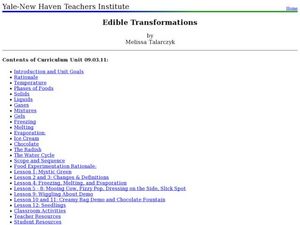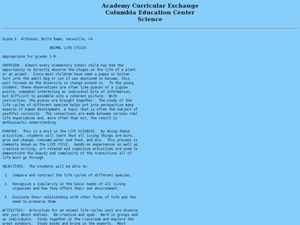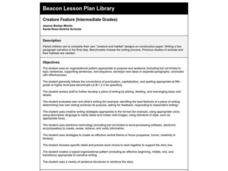Curated OER
Water Resources
Students study water resources that are important to the people of North American and Africa. They use satellite images and data to explore how human actions can degrade, improve, or maintain water resources. They analyze and interpret...
Curated OER
"ART ZOO 'Blacks in the Westward Movement', 'What Can You Do with a Portrait', and 'Of Beetles, Worms, and Leaves of Grass'"
Students study black history, examine portraits and portrait making and create their own portraits, and investigate their natural environment. This humanities lesson provides a text that can be used to teach lessons in black...
Curated OER
Understanding How Potatoes Grow
Second graders make a KWL chart and brainstorm what they need for the project of growing potatoes. They choose one potato and plant it in water or peat moss cups and choose a location in which meets the needs of the plants and make their...
Curated OER
Living with Disaster: Mother Nature Rules
Students analyze various types of natural disasters and discover techniques man uses to live with nature and to control nature. They are able to identify ways that man has learned to predict natural disasters; identify ways that man has...
Curated OER
Earth Book
After viewing a teacher-led demonstration on a variety of landforms of the Earth, 1st graders create an Earth book. This nicely-done hands-on lesson has students produce books that describe, in pictures and words, different aspects of...
Curated OER
Edible Transformations
Learners differentiate the different phases of matter. In this chemistry lesson, students conduct several hands-on exercises to discover how matter transforms when mixed together. They identify the different stages in the water cycle.
Institute of Electrical and Electronics Engineers
Flashlights and Batteries
Students examine how batteries work, how they provide power to the simple circuit within the battery, and how the switch controls the flow of electrons; students then disassemble a flashlight, and draw a schematic of a flashlight's...
Curated OER
CONVERTING ENERGY
Students explore energy through the idea of energy transformations and conversions, and to develop students' ideas of what energy is and how it can be measured.
Curated OER
Where Do Plants Get Their Food?
Students think about the historical development of the scientific method. They design an experiment that replicates van Helmont's, using only specified materials. Pupils then improved upon van Helmont's procedure and also consider the...
Curated OER
Enduring Understanding
Fourth graders explore indigenous people of rainforest and examine their customs and ways of life. They discuss how rainforests should be protected not only for their plants and animals, but also for indigenous people who live in them,...
Curated OER
Earthquakes Study Guide
In this earthquakes worksheet, students answer questions about the components of earthquakes, the causes of earthquakes, how they are measured, the types of seismic waves and the types of faults. They also answer questions about the...
Curated OER
Animal Life Cycle
Students conduct hands-on experiments. In this life cycle lesson, students are able to observe a variety of animals as they travel through their life cycle (brine shrimp, mealworms, frog eggs and chicken eggs). Students respond to what...
Curated OER
Parachutes: What a Drag
Sixth graders make 2 different kinds of parachutes and record and graph the time for each one for the different drag forces. In this parachute lesson plan, 6th graders compare the results to the rest of the class of each parachute and...
Curated OER
Web of Predators and Prey
Students investigate the food chain by researching the Internet. In this ecosystem lesson, students view the video "Competitor and Predator" and read a book from the series "The Magic School Bus." Students utilize a worksheet...
Curated OER
Wood You Believe: Wood Products
In this wood products lesson plan, students walk to a forest near their school where they sit by themselves for a few minutes and quietly observe their surroundings. Students brainstorm wood or wood by products, discuss everything we get...
Curated OER
Plants and Animals
Students find common needs between plants and animals. In this plants and animals lesson students compare that both plants and animals need food and water. They also find the differences between plant and animal needs.
Curated OER
Creek Detectives WISE On-line Research Community
Students investigate ways people cause harm to the environment. In this environmental lesson, students explore a case study on the Internet. Students explore all of the online activities and collect data for a presentation.
Curated OER
Growth Stages 1: Infancy and Early Childhood
Learners explore biology by completing a human growth worksheet. In this child development lesson, students read assigned text about the human birth process and the ideal growth patterns for a child. Learners answer study questions about...
Curated OER
Introduction to Ocean Grazers
Students explore biology by creating a poster with classmates. In this oceanography instructional activity, students identify the importance of coral reefs to the ocean's ecology and examine a food web of ocean animals. Students define a...
Curated OER
Ocean Grazers: Class Field Trip
Students explore biology by participating in a field trip. In this oceanography lesson, students define the survival characteristics of bottom dwelling creatures also known as ocean grazers. Students attend a class field trip to a beach...
Curated OER
On the Attack
Students explore how government restrictions and over fishing impact the ecosystems of sharks and contribute to or curb their danger to humans. They synthesize their understanding of the issues by creating board games in groups.
Curated OER
Creature Feature
Students work in pairs to create a creature and its habitat out of construction paper. Then students write a narrative to describe the animal and its habitat.
Curated OER
Physics Park
Students research and design a playground for a park or school in their community. They explore the physics concepts that are present in the design and, if applicable promote their ideas to city or school officials.
Institute of Electrical and Electronics Engineers
Critical Load
Young scholars analyze critical load and how to reinforce the design of a structure to hold more weight. They examine basic structures and which materials to select. They create a prototype to hold more and more weight.























